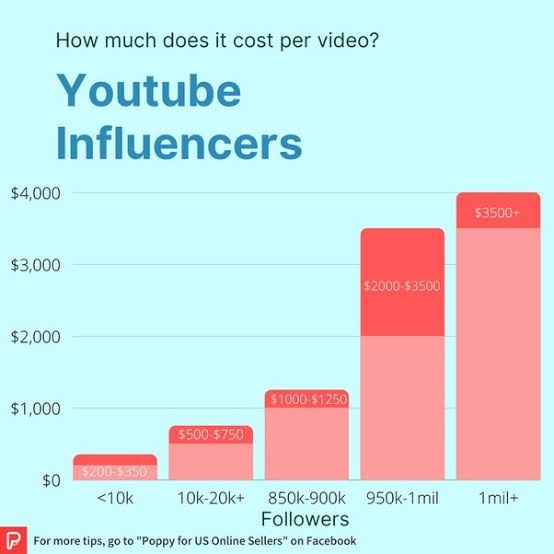The reality is: if you’re canny and creative with billing, any YouTuber can make a fortune from sponsorships, irrespective of their niche. Brands want to work with people that have an identifiable audience and consistent output.
One of the most common rules of thumb is to charge $10 per 1,000 followers. But that’s apparently just a general rule of thumb; your mileage will vary.
Cost-per-mille (CPM)
One of the ways brand advertises on Youtube is through a Youtube sponsorship. This is when the brand pays the creator of the video to talk about and show its items. Usually sponsorship payment depends on the number of views such video reaches. The brand can either pay a certain amount per each video or they can measure their payment depending on the amount or the number of subscribers the creator has.
By far the most common form of YouTube sponsored content is branded or product mention at the beginning or middle of a video – and this is so easy to do! Anyone with a YouTube account and the ability to enabled YouTube monetisation can do this.
Ads pay, merchandise sales pay, and so do subscriptions. Some channels earn millions of views a year and thus earn a substantial amount of money – but it’s still a lot of work to get there, and not everyone is successful. Other entrepreneurs earn from the sale of goods and services, such as digital products like online courses or digital downloads.
Cost-per-sale (CPS)
The CPS (Cost Per Sale) is the second important metric in influencer advertising, which gives the amount of investment costs needed to get one selling order from a sponsored video. You can adjust this indicator to evaluate the efficiency of your advertising campaign for making sales, and also set the best strategy to maximise your sales. CPS is extremely important for the dynamics of SMM (social media marketing).
I think many people accept that YouTubers earn large amounts of money through a few entertaining videos. In reality, YouTubers have to work hard to create a video. They have to come up with the content, shoot it, edit it and then go through its post-production. Afterward, they still have to deal with its distribution and promotion.
How these deals can be lucrative for companies as well as influencers I would like to write to you about a skill which I have and which could be potentially interesting for brands: video editing.
While video editing has been highly valued for years, in the recent past the rules used to calculate the price of that service have simplified and this is great news for you.
Basically, prices are now based on the number of views instead of an extremely more complex mathematical set of rules. With this in mind, I’d like to propose you today two deals.
For the low score of your channel I’m proposing my own version of your video for $100 or if you prefer, I’d like to present you my prices for hiring me for professional work.
Cost-per-click (CPC)
I’m going to say it again: the average CPC on YouTube is different for every channel, for different niches and may be different for different types of video content. However, generically speaking, there is an increase in median CPC as the number of views for a certain video goes up. The niche most preferred by YouTube for video creation is specialized, think of stock investing and educational content. S.I. MukherjeeAs you may guess, audiences for stocks and education are generally more middle-aged individuals with an increased income and more disposable money.
Besides advertising revenues, YouTubers also earn from affiliate revenues. These are links that direct viewers to merchant sites where they can make purchases or sign up to services. These contracts are ideal for the smaller channels.
Another way to make money on YouTube is through branded content sponsorships. Brands typically work with influencer agencies that search for talent and negotiate sponsorship deals for YouTubers. Brands want to work with those who have massive followings. Companies often work with gaming or lifestyle channels.
Perhaps the most lucrative form of sponsorship is product review. Companies send creators goods for free to be promoted. Creators would share links to these products in their videos. These items vary from makeup and clothes to flashy gadgets.
Cost-per-lead (CPL)
If you are in a business, you are very likely interested in how high-quality leads are performing. A very important key performance indicator (KPI) that tells you about the quality of the leads you are getting is cost per lead (CPL). For example, let’s say you are a retailer and the CPL of your fashion line’s advertising campaign is $6.50. In this case, your campaign is really good. Basically, it means you can go through your account and look at who is running your campaign, spending more money on your campaign, and auditing your results. Then, you can optimise your targeting, placements, and ads to make the campaign’s results more impressive.
You can use the CPL metric to measure the performance of a campaign, and also spot blockages preventing a lead from becoming a confirmed lead. But ultimately it is only one metric in a full marketing strategy, not the measure of a campaign’s actual success.
collaboration with brands on branded content videos. For example, the popular gamer Jacksepticeye has made several branded content videos for companies like Disney, Google Play and Hot Pockets, promoting their various products, which have earned him millions of dollars.
